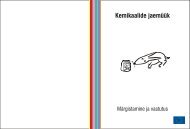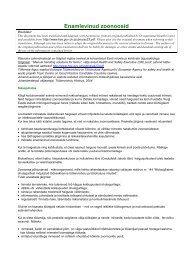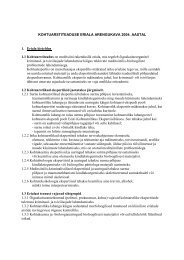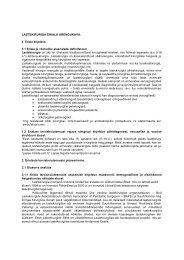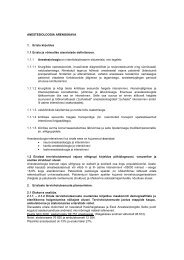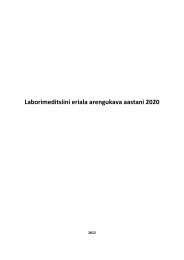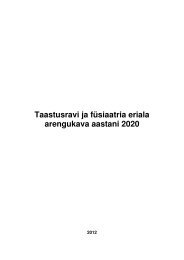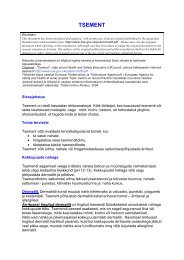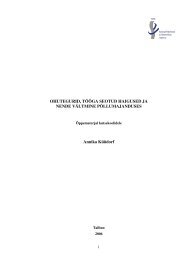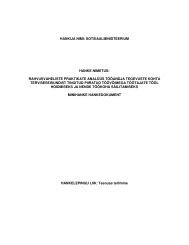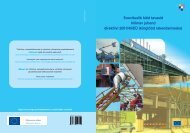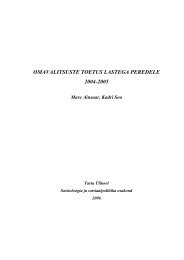Occupational Health and Safety Requirements at Construction Sites
Occupational Health and Safety Requirements at Construction Sites
Occupational Health and Safety Requirements at Construction Sites
- No tags were found...
You also want an ePaper? Increase the reach of your titles
YUMPU automatically turns print PDFs into web optimized ePapers that Google loves.
5) a plan for assembly <strong>and</strong> dismantling of scaffolding, if it is used on the construction site;6) a plan for performance of work with asbestos if it is prescribed by the Government of theRepublic Regul<strong>at</strong>ion “<strong>Occup<strong>at</strong>ional</strong> <strong>Health</strong> <strong>and</strong> <strong>Safety</strong> <strong>Requirements</strong> for Work with Asbestos” <strong>and</strong>has not been submitted as a separ<strong>at</strong>e document;7) instructions for action in the event of a risk of an accident, the names <strong>and</strong> contact details ofpersons responsible for leading people out of the danger zone <strong>and</strong> performance of rescue work;8) organis<strong>at</strong>ion of first aid on a construction site, the names <strong>and</strong> contact details of persons givingfirst aid, the nearest place of providing emergency medical assistance.(4) In addition to the list of construction work involving particular risks specified in 5, the resultsof a risk assessment of the work process <strong>and</strong> inform<strong>at</strong>ion about the measures set out in thebuilding design document<strong>at</strong>ion which need to be applied <strong>at</strong> each stage of the construction work forensuring the occup<strong>at</strong>ional health <strong>and</strong> safety of workers shall be taken into account upondetermining the hazardousness of a construction site.(5) A layout of a construction site constitutes a part of a safety <strong>and</strong> health plan. The layout shallindic<strong>at</strong>e the following:1) the loc<strong>at</strong>ion of office rooms <strong>and</strong> non-work rooms on the construction site;2) the places for the unloading <strong>and</strong> storage of m<strong>at</strong>erials;3) the places for the storage of waste;4) the loc<strong>at</strong>ion of install<strong>at</strong>ions <strong>and</strong> equipment;5) the collection sites for aggreg<strong>at</strong>es or soil;6) the places of overhead transmission lines <strong>and</strong> other technical install<strong>at</strong>ions, including otherhazards in the soil, which existed before cre<strong>at</strong>ion of the construction site;7) the loc<strong>at</strong>ion of access routes <strong>and</strong> danger zones;8) access routes for rescue or ambulance crews;9) the loc<strong>at</strong>ion of basic fire extinguishing equipment, first aid equipment <strong>and</strong> emergency phone;10) the loc<strong>at</strong>ion of emergency routes <strong>and</strong> exits.[RT I 2009, 25, 155 – entered into force 1.07.2009]§ 5. List of work involving particular risksAbove all, the following is deemed to be work involving particular risks:1) work which puts workers <strong>at</strong> risk of burial under cave-ins or engulfment, where the risk isparticularly aggrav<strong>at</strong>ed by the work methods used or by the environment on the construction site;2) work which puts workers <strong>at</strong> risk from biological agents or dangerous chemicals, incl. asbestos;4
3) work with ionising radi<strong>at</strong>ion;4) work near high voltage power lines <strong>and</strong> transformer subst<strong>at</strong>ions;5) work exposing workers to the risk of drowning;6) work performed underground, e.g. in a well, tunnel;7) work in w<strong>at</strong>er, which requires the use of an air supply system;8) work in caissons;9) work involving the use of explosives;10) work involving the lifting, assembly <strong>and</strong> dismantling of heavy prefabric<strong>at</strong>ed components;11) work which puts workers <strong>at</strong> risk of falling from a height;12) work involving the requirement to examine the health of workers.[RT I 2009, 25, 155 – entered into force 1.07.2009]§ 6. Performance of construction work(1) The general contractor shall appoint in writing one coordin<strong>at</strong>or or several coordin<strong>at</strong>ors for theperiod of performance of work on a shared construction site. If no general contractor has beenappointed, a coordin<strong>at</strong>or shall be appointed by the owner of the construction works.(2) Appointment of a coordin<strong>at</strong>or does not release a building contractor or the owner of aconstruction works from the liability for performance of their duties <strong>and</strong> oblig<strong>at</strong>ions.(3) During performance of construction work a coordin<strong>at</strong>or shall:1) organise <strong>and</strong> coordin<strong>at</strong>e occup<strong>at</strong>ional safety activities on a construction site;2) ensure the introduction of the safety <strong>and</strong> health plan to workers working on a sharedconstruction site, their employers, self-employed workers, <strong>and</strong> other persons;3) verify adherence to the safety <strong>and</strong> health plan <strong>and</strong> upd<strong>at</strong>e the plan if the work is changed;4) make certain th<strong>at</strong> all underground <strong>and</strong> on-ground cables, pipes <strong>and</strong> other install<strong>at</strong>ions <strong>and</strong>danger zones are marked <strong>and</strong> the necessary safety measures taken;5) make certain th<strong>at</strong> persons working on the construction site <strong>and</strong> persons allowed to access theconstruction site are equipped with personal protective equipment corresponding to the danger;6) organise regular general inspection of a shared construction site.[RT I 2009, 25, 155 – entered into force 1.07.2009]5
§ 7. Inspection of construction site(1) A general inspection involving inspection of the order on a construction site <strong>and</strong> compliancewith the occup<strong>at</strong>ional health <strong>and</strong> safety requirements set out in Chapter 2 shall be conducted onthe construction site <strong>at</strong> least once a week. A coordin<strong>at</strong>or shall carry out a general inspection on ashared construction site.(2) In the course of a general inspection it is checked th<strong>at</strong> the tools used in construction, incl.scaffolding, ladders <strong>and</strong> lifting equipment are in a good condition in accordance wit therequirements established on the basis of subsection 5 (4) of the <strong>Occup<strong>at</strong>ional</strong> <strong>Health</strong> <strong>and</strong> <strong>Safety</strong>Act.(3) Before scaffolding, work pl<strong>at</strong>forms <strong>and</strong> ladders are used on a construction site, <strong>and</strong> in additionto the general inspection specified in subsection (2) where they have been exposed to strong wind,heavy equipment or heavy loads or where they have not been used for more than one month, aninspection shall be carried out to check th<strong>at</strong> they are in good condition. Special <strong>at</strong>tention shall bepaid to support <strong>and</strong> protective shuttering.(4) A st<strong>at</strong>ement which sets out the persons particip<strong>at</strong>ing in the inspection, the time, defectsdetected <strong>and</strong> any possible suggestions for changes shall be prepared concerning an inspectioncarried out on a construction site. A worker who uses the tool under inspection is allowed toparticip<strong>at</strong>e in the inspection.(5) Any defects detected during the inspection shall be elimin<strong>at</strong>ed as soon as possible or beforeusing the tool again.(6) If conditions which are dangerous for the life of persons working on a construction site or otherpersons become evident in the course of an inspection, the performance of the dangerous work orthe use of the dangerous tool shall be suspended until the defects are elimin<strong>at</strong>ed.[RT I 2009, 25, 155 – entered into force 1.07.2009]§ 8. [Repealed – RT I 2009, 25, 155 – entered into force 1.07.2009]Chapter 2OCCUPATIONAL HEALTH AND SAFETY REQUIREMENTS FOR CONSTRUCTION SITESDivision 1General <strong>Requirements</strong>§ 9. Stability <strong>and</strong> solidity(1) Buildings <strong>and</strong> working premises shall have the structure <strong>and</strong> strength corresponding to theirpurpose of use.(2) Transparent walls in the vicinity of workst<strong>at</strong>ions <strong>and</strong> traffic routes shall be made of a safem<strong>at</strong>erial or be protected against breaking <strong>and</strong> be clearly marked.(3) M<strong>at</strong>erials, equipment <strong>and</strong> objects which, when moving, may endanger the life <strong>and</strong> health ofworkers, shall be stabilised in an appropri<strong>at</strong>e <strong>and</strong> safe manner.6
(2) <strong>Safety</strong> belts equipped with safety ropes shall be used while working on scaffolding, roofs <strong>and</strong>work pl<strong>at</strong>forms <strong>and</strong> in other places where falling from a height cannot be prevented by other safetymeasures.(3) <strong>Safety</strong> footwear shall be generally used on construction sites. Kneepads shall be used whileworking on the floor or during other work involving kneeling.(4) If work is performed in the dark or underground, a reflex reflector or a reflector-b<strong>and</strong> shall beworn on clothing. If work is performed in places in the vicinity of traffic, the worker shall wear abright waistco<strong>at</strong> or clothing <strong>and</strong>, in the dark, also a reflector-b<strong>and</strong>. A reflector-b<strong>and</strong> shall be<strong>at</strong>tached in a visible place <strong>and</strong>, if necessary, also to a protective helmet.(5) If workers have to enter a high-risk area, e.g. an area where the <strong>at</strong>mosphere containsdangerous chemicals, has an insufficient oxygen level or is inflammable, the workers shall usepersonal protective equipment in order to prevent any damage to their health.[RT I 2009, 25, 155 – entered into force 1.07.2009]§ 16. Temper<strong>at</strong>ure(1) The temper<strong>at</strong>ure in the rooms on the construction site where workst<strong>at</strong>ions are loc<strong>at</strong>ed shall beappropri<strong>at</strong>e for the workers, having regard to the n<strong>at</strong>ure of the work <strong>and</strong> the physical dem<strong>and</strong>splaced on the workers.(2) The temper<strong>at</strong>ure in non-work rooms shall correspond to their purpose of use.[RT I 2009, 25, 155 – entered into force 1.07.2009]§ 17. Lighting(1) The lighting of workst<strong>at</strong>ions, rooms <strong>and</strong> traffic routes shall be sufficient <strong>and</strong> preference shall begiven to n<strong>at</strong>ural lighting. Artificial lighting shall be provided <strong>at</strong> night <strong>and</strong> when n<strong>at</strong>ural daylight isinsufficient; where necessary, portable light sources th<strong>at</strong> are protected against impact shall beused.(2) Large differences in lighting <strong>and</strong> dazzling shall be avoided. Where required, the lighting of aworkst<strong>at</strong>ion shall be increased according to the worker's age or health st<strong>at</strong>us.(3) The minimum permitted intensity of the lighting throughout traffic routes is 25 lux.(4) The colour of artificial light used shall not alter or affect the perception or visibility of safetysigns, signposts <strong>and</strong> marked objects.(5) Lighting install<strong>at</strong>ions for work rooms, workst<strong>at</strong>ions <strong>and</strong> traffic routes shall be placed in such away th<strong>at</strong> there is no risk of accident to workers.(6) Work rooms, workst<strong>at</strong>ions <strong>and</strong> traffic routes where workers are exposed to risks in the event offailure of artificial lighting shall be provided with emergency lighting.[RT I 2009, 25, 155 – entered into force 1.07.2009]9
§ 18. Doors <strong>and</strong> g<strong>at</strong>es(1) Sliding doors shall be fitted with a safety device to prevent them from derailing <strong>and</strong> fallingover.(2) Doors <strong>and</strong> g<strong>at</strong>es opening upwards shall be fitted with a mechanism or another protection tosecure them against falling back.(3) If it is unsafe for pedestrians to cross g<strong>at</strong>es intended primarily for vehicle traffic, there shall bedoors for pedestrian traffic in the immedi<strong>at</strong>e vicinity of the g<strong>at</strong>es. Such g<strong>at</strong>es shall be clearlymarked <strong>and</strong> kept free <strong>at</strong> all times.(4) Power-oper<strong>at</strong>ed doors <strong>and</strong> g<strong>at</strong>es shall oper<strong>at</strong>e without any risk of accident to workers <strong>and</strong> shallbe fitted with emergency stop devices which are easily identifiable <strong>and</strong> accessible. If poweroper<strong>at</strong>eddoors <strong>and</strong> g<strong>at</strong>es do not open autom<strong>at</strong>ically in the event of a power-cut, it shall bepossible for them to be opened manually.(5) Transparent doors shall be made of a safe m<strong>at</strong>erial or be protected against breaking <strong>and</strong> beclearly marked.(6) Revolving doors <strong>and</strong> g<strong>at</strong>es <strong>and</strong> swing doors shall be transparent or with a transparent sighthole.[RT I 2009, 25, 155 – entered into force 1.07.2009]§ 19. Traffic routes <strong>and</strong> danger zones(1) Traffic routes, including all stairs, fixed ladders <strong>and</strong> loading bays <strong>and</strong> ramps, shall be designed,loc<strong>at</strong>ed <strong>and</strong> laid out to ensure safe use <strong>and</strong> easy access in such a way as not to endanger personsemployed in the vicinity of these traffic routes.(2) Routes used for pedestrian traffic <strong>and</strong> vehicle traffic shall be dimensioned in accordance withthe number of potential users <strong>and</strong> the type of activity concerned.(3) If means of transport are used on traffic routes, a sufficient safety clearance or adequ<strong>at</strong>eprotective devices shall be provided for pedestrians.(4) Sufficient clearance shall be allowed between vehicle traffic routes <strong>and</strong> doors, g<strong>at</strong>es, passages<strong>and</strong> staircases for pedestrians.(5) Routes shall be clearly marked, regularly checked <strong>and</strong> properly maintained.(6) If a construction site includes limited-access danger zones, these shall be signposted <strong>and</strong>equipped with devices to prevent unauthorised persons from entering. Only workers who havereceived special training may work in danger zones <strong>and</strong> appropri<strong>at</strong>e measures shall be taken toprotect these workers.§ 20. Loading bays <strong>and</strong> ramps(1) Loading bays <strong>and</strong> ramps shall be suitable for the dimensions of the means of transport or theloads to be transported.(2) Loading bays shall have <strong>at</strong> least one exit point.10
(3) Loading bays <strong>and</strong> ramps shall be safe.§ 21. Freedom of movement <strong>at</strong> workst<strong>at</strong>ion(1) The floor area <strong>at</strong> a workst<strong>at</strong>ion shall be such as to allow workers sufficient freedom ofmovement to perform their work, taking account of any necessary m<strong>at</strong>erials <strong>and</strong> work equipmentpresent.(2) The floors of workplaces shall not be slippery <strong>and</strong> shall have no dangerous bumps, holes orslopes.§ 22. First aid(1) First aid by a respectively trained worker shall be guaranteed for workers who have had anaccident or have suddenly been taken ill on the site.(2) A construction site shall be equipped with means for transporting an injured or ill worker to aroom where first aid can be provided <strong>and</strong> to where a victim can, if necessary, be removed until thearrival of medical care. This room shall be accessible with a stretcher.(3) <strong>Construction</strong> sites shall be equipped with first aid kits <strong>and</strong> eyewash. First aid equipment shallbe marked in accordance with the requirements.(4) A construction site shall have a telephone connection to emergency call number 112. Theemergency call number shall be displayed in a visible place.(5) If work exposes workers to the risk of drowning, life saving equipment <strong>and</strong> a worker whoknows how to use the equipment shall be present on the construction site.[RT I 2009, 25, 155 – entered into force 1.07.2009]§ 23. Non-work rooms(1) By the time of commencement of construction work non-work rooms shall be ready for use onthe construction site. The rooms shall be constructed <strong>and</strong> furnished having regard to the workingconditions <strong>and</strong> the number <strong>and</strong> gender of the workers. The non-work rooms shall be kept in order<strong>and</strong> they shall be cleaned regularly.(2) Non-work rooms shall generally be loc<strong>at</strong>ed on the construction site or as close to theconstruction site as possible. In the case of a construction site which is moved in stages, forexample during road construction, or if the dur<strong>at</strong>ion of construction work on the site does notexceed 2 weeks, changing rooms <strong>and</strong> drying <strong>and</strong> washing facilities may be loc<strong>at</strong>ed in the placewhere the workers assemble.(3) Changing rooms shall be provided for workers who are required to wear working clothes. Thechanging rooms shall be sufficiently large <strong>and</strong> be equipped with se<strong>at</strong>s <strong>and</strong> lockers. Separ<strong>at</strong>e lockersor sections shall be for workers’ working clothes <strong>and</strong> their own clothes. If no changing rooms arenecessary for workers, a place for keeping workers’ own clothes <strong>and</strong> personal effects shall beensured for each worker. Provision shall be made for separ<strong>at</strong>e changing rooms for men <strong>and</strong> womenor the use of the changing room <strong>at</strong> different times shall be organised.11
(4) Depending on the n<strong>at</strong>ure of work, a drying chamber or dry boxes which are large enough, wellventil<strong>at</strong>ed <strong>and</strong> <strong>at</strong> an appropri<strong>at</strong>e temper<strong>at</strong>ure shall be provided for the drying of wet or dampclothes <strong>and</strong> footwear. The moist air coming from the drying chamber or dry boxes shall not enterother rooms.(5) According to the n<strong>at</strong>ure of the work, a sufficient number of showers with hot <strong>and</strong> cold runningw<strong>at</strong>er shall be provided for workers, meaning not less than 1 shower for up to 15 workers. Ifshowers are not necessary, workers shall be provided with the possibility to use washbasins withcold <strong>and</strong>, where required, hot w<strong>at</strong>er, thereby there shall be no less than 1 washbasin for up to 10workers. The washing facilities shall be provided in the vicinity of the changing rooms. Provisionshall be made for separ<strong>at</strong>e washing facilities for men <strong>and</strong> women or the use of the washingfacilities <strong>at</strong> different times shall be organised.(6) Provision shall be made for separ<strong>at</strong>e lav<strong>at</strong>ories for men <strong>and</strong> women on the construction site,where possible. The lav<strong>at</strong>ories shall be loc<strong>at</strong>ed in the vicinity of workst<strong>at</strong>ions <strong>and</strong> washing <strong>and</strong>drying facilities. A lav<strong>at</strong>ory shall be equipped with facilities for washing <strong>and</strong> drying h<strong>and</strong>s. Anadequ<strong>at</strong>e number of lav<strong>at</strong>ories shall be provided for workers, meaning not less than 1 lav<strong>at</strong>ory forevery 15 workers.(7) Workers shall be provided with facilities enabling them to take their meals <strong>and</strong> rest ins<strong>at</strong>isfactory conditions. If meals are not provided for the workers on the site, they shall be providedwith facilities enabling them to preserve the foodstuffs they have brought with them <strong>and</strong>, ifnecessary, to he<strong>at</strong> them.(8) If a barrack or rest room is required due to the n<strong>at</strong>ure of the work or the loc<strong>at</strong>ion of theconstruction site, it shall be of sufficient size <strong>and</strong> contain an adequ<strong>at</strong>e number of tables <strong>and</strong> chairswith back support, considering the number of workers.(9) If there is no rest room on the construction site, another room shall be furnished as a placewhere the workers can stay during breaks.(10) If it is necessary to regularly accommod<strong>at</strong>e workers on the construction site due to the n<strong>at</strong>ureof the work or the loc<strong>at</strong>ion of the construction site, bedrooms of a sufficient size shall be providedfor such purpose. The rooms shall be equipped with a number of beds, cupboards, tables <strong>and</strong>chairs with backs, which corresponds to the number of workers. Upon planning the bedrooms thegender of the workers shall be taken into account.[RT I 2009, 25, 155 – entered into force 1.07.2009]Division 2Special <strong>Requirements</strong> for Outdoor Workst<strong>at</strong>ions§ 24. Stability <strong>and</strong> solidity(1) High-level or low-level workst<strong>at</strong>ions shall be solid <strong>and</strong> stable, taking account of the number ofworkers occupying them, the weight distribution <strong>and</strong> the maximum loads they may have to bear,<strong>and</strong> the outside influences to which they may be exposed to.(2) If the support <strong>and</strong> other components of these workst<strong>at</strong>ions are not intrinsically stable, theirstability shall be ensured by appropri<strong>at</strong>e <strong>and</strong> safe methods of fixing.12
(3) The stability <strong>and</strong> solidity of workst<strong>at</strong>ions shall be checked regularly <strong>and</strong> especially after anychange in the height of the workst<strong>at</strong>ion.§ 25. Outdoor energy distribution install<strong>at</strong>ions(1) On-site energy distribution install<strong>at</strong>ions, especially those exposed to outside influences, shall beregularly checked <strong>and</strong> maintained.(2) Install<strong>at</strong>ions existing before the site began shall be identified, checked <strong>and</strong> clearly signposted.(3) Whenever possible, where unnecessary overhead electric power lines exist, either they shall beredirected away from the area of the site or else the current shall be cut off. If this is not possible,the power lines shall be supplied with warning signs to ensure th<strong>at</strong> vehicles <strong>and</strong> install<strong>at</strong>ions arekept away.§ 26. Atmospheric influencesWorkers shall be protected against <strong>at</strong>mospheric influences which could affect their safety or health.§ 27. Falling objects(1) Workers shall be protected by collective methods against falling objects. Where necessary,there shall be covered passageways or access to danger areas shall be made impossible.(2) M<strong>at</strong>erials <strong>and</strong> equipment shall be laid out or stacked in such a way as to prevent theircollapsing or overturning.§ 28. Scaffolding <strong>and</strong> ladders(1) Generally, scaffolding shall be industrial or manufactured according to the design of a civilengineer or designer.(2) All scaffolding shall be properly designed, constructed <strong>and</strong> maintained to ensure th<strong>at</strong> it does notcollapse or move accidentally.(3) Work pl<strong>at</strong>forms, gangways <strong>and</strong> scaffolding stairways shall be constructed, dimensioned <strong>and</strong>used in such a way as to prevent people from falling or being exposed to falling objects.(4) Ladders shall be sufficiently strong <strong>and</strong> correctly maintained. Ladders shall be used inaccordance with their intended purpose.(5) Mobile scaffolding shall be secured against spontaneous movements.(6) The earth on which scaffolding is loc<strong>at</strong>ed shall be levelled <strong>and</strong> fl<strong>at</strong>tened. Provision shall bemade for leading off rain w<strong>at</strong>er therefrom.(7) Scaffolding which is loc<strong>at</strong>ed near traffic routes or in places where loads are lifted shall beprotected against impact, damage <strong>and</strong> accidental movements. The danger zone shall be separ<strong>at</strong>edby barriers <strong>and</strong> supplied with warning signs.13
§ 29. Lifting equipment(1) All lifting devices <strong>and</strong> accessories, including their accessories, component parts, supports <strong>and</strong>anchors, shall be properly designed, constructed <strong>and</strong> installed <strong>and</strong> sufficiently strong for the use towhich they are put, <strong>and</strong> they shall be maintained in good working order.(2) Lifting equipment may only be oper<strong>at</strong>ed by workers who have received the appropri<strong>at</strong>etraining.(3) All lifting devices <strong>and</strong> accessories shall clearly display their maximum load values.(4) Lifting equipment <strong>and</strong> accessories may not be used for other than their intended purposes.§ 30. Excav<strong>at</strong>ing <strong>and</strong> m<strong>at</strong>erials-h<strong>and</strong>ling vehicles <strong>and</strong> machinery(1) All excav<strong>at</strong>ing <strong>and</strong> m<strong>at</strong>erials-h<strong>and</strong>ling vehicles <strong>and</strong> machinery shall be checked <strong>and</strong> testedbeforeh<strong>and</strong> <strong>and</strong> kept in good working order.(2) Drivers <strong>and</strong> oper<strong>at</strong>ors of excav<strong>at</strong>ing <strong>and</strong> m<strong>at</strong>erials-h<strong>and</strong>ling vehicles <strong>and</strong> machinery shall bespecially trained.(3) Preventive measures shall be taken to ensure th<strong>at</strong> excav<strong>at</strong>ing <strong>and</strong> m<strong>at</strong>erials-h<strong>and</strong>ling vehicles<strong>and</strong> machinery do not fall into the excav<strong>at</strong>ions or into w<strong>at</strong>er.(4) Where appropri<strong>at</strong>e, excav<strong>at</strong>ing <strong>and</strong> m<strong>at</strong>erials-h<strong>and</strong>ling vehicles <strong>and</strong> machinery shall be fittedwith structures to protect the oper<strong>at</strong>or or driver against being crushed if the machine overturns,<strong>and</strong> against falling objects.§ 31. Excav<strong>at</strong>ions, wells, underground works, tunnels <strong>and</strong> earthworks[RT I 2009, 25, 155 – entered into force 1.07.2009](1) Suitable precautions shall be taken when working in an excav<strong>at</strong>ion, well or tunnel orunderground:[RT I 2009, 25, 155 – entered into force 1.07.2009]1) to use an appropri<strong>at</strong>e support or embankment;2) to prevent hazards entailed in the fall of a person, objects or m<strong>at</strong>erials, or flooding;3) to provide sufficient ventil<strong>at</strong>ion <strong>at</strong> all workst<strong>at</strong>ions so as to ensure a bre<strong>at</strong>hable <strong>at</strong>mosphere;4) to enable workers to reach safety in the event of fire or inrush of w<strong>at</strong>er or m<strong>at</strong>erials.(2) Before excav<strong>at</strong>ion starts, measures shall be taken to identify <strong>and</strong> reduce to a minimum anyhazard due to underground cables <strong>and</strong> other distribution systems.(3) Safe routes into <strong>and</strong> out of excav<strong>at</strong>ions, wells or tunnels shall be provided.[RT I 2009, 25, 155 – entered into force 1.07.2009]14
(4) Piles of earth, m<strong>at</strong>erials <strong>and</strong> moving vehicles shall be kept away from the excav<strong>at</strong>ion <strong>and</strong>, ifnecessary, appropri<strong>at</strong>e barriers shall be built.§ 32. Cofferdams <strong>and</strong> caissons(1) All cofferdams <strong>and</strong> caissons shall be:1) well-constructed, of appropri<strong>at</strong>e, solid m<strong>at</strong>erials of adequ<strong>at</strong>e strength;2) appropri<strong>at</strong>ely equipped so th<strong>at</strong> workers can gain shelter in the event of an irruption of w<strong>at</strong>er <strong>and</strong>m<strong>at</strong>erials.(2) The construction, install<strong>at</strong>ion, transform<strong>at</strong>ion, dismantling or inspection of a cofferdam orcaisson shall take place only under the supervision of a competent person.§ 33. Install<strong>at</strong>ions, machinery, equipmentInstall<strong>at</strong>ions, machinery <strong>and</strong> work equipment, including h<strong>and</strong> tools, whether power-driven or not,shall be kept in good working order. Install<strong>at</strong>ions, machinery <strong>and</strong> work equipment shall be usedsolely for the work for which they were designed <strong>and</strong> oper<strong>at</strong>ed by workers who have receivedappropri<strong>at</strong>e guidance <strong>and</strong> training.§ 34. Demolition work(1) Upon the demolition of a construction works or a civil engineering works, appropri<strong>at</strong>eprecautions shall be adopted <strong>and</strong> the demolition work shall be undertaken only under thesupervision of a competent person.(2) Before the commencement of demolition work, it shall be verified th<strong>at</strong> the site to be demolishedis disconnected from all possible electricity, gas, w<strong>at</strong>er <strong>and</strong> other supplies.(3) Special requirements apply to the demolition of constructions which contain asbestos.(4) Dusty waste <strong>and</strong> m<strong>at</strong>erials may be removed from a site only through tubes. A dusty load shallbe covered during carriage.§ 35. Metal or concrete frameworks, shuttering <strong>and</strong> heavy prefabric<strong>at</strong>ed components(1) Metal or concrete frameworks <strong>and</strong> their components, shuttering, prefabric<strong>at</strong>ed components,temporary support <strong>and</strong> buttresses may be erected <strong>and</strong> dismantled only under the supervision of acompetent person.(2) Adequ<strong>at</strong>e precautions shall be taken to protect workers against risks arising from thetemporary fragility or instability of civil engineering works.(3) Shuttering, temporary supports <strong>and</strong> buttresses shall be designed, installed <strong>and</strong> maintained soas to safely withst<strong>and</strong> any strains <strong>and</strong> stresses which may be placed on them.§ 36. Risk of falling from height, <strong>and</strong> work on roofs(1) If there is a risk of falling from a height while working or moving <strong>and</strong> if the height of the fallwould exceed 2 metres, safety devices such as cradles, safety nets <strong>and</strong> other equivalent protectiondevices shall be used. If the use of such equipment is impossible because of the n<strong>at</strong>ure of the15
work, workers shall be provided with a safety belt or safety harnesses to be affixed with safetycables or ropes, or other anchoring safety methods shall be used in order to ensure safety.(2) Additionally, protection devices shall also be used if the height of the fall would be less but if,because of the n<strong>at</strong>ure of the work, there exists a particular risk of falling or a risk of falling to theground rel<strong>at</strong>ed to the particular risk.(3) A cradle which is placed in order to prevent falls from a height shall have a h<strong>and</strong>rail which is ofa height of <strong>at</strong> least 1 metre, an end-board, <strong>and</strong> an intermedi<strong>at</strong>e h<strong>and</strong>rail <strong>at</strong> a height of 0.5 metresbetween the h<strong>and</strong>rail <strong>and</strong> end-board. The intermedi<strong>at</strong>e h<strong>and</strong>rail may be replaced by pl<strong>at</strong>es or netsintended for such use. Cradles shall be placed to the free sides of work pl<strong>at</strong>forms or traffic routeswhere the height of a fall would be <strong>at</strong> least 2 metres. Scaffolding shall be equipped with cradles ifthe height of a fall would be <strong>at</strong> least 2 metres.(4) If the slope of a roof is less than 15° <strong>and</strong> the eaves are higher than 3.5 metres from theground, a cradle with three horizontal bars shall be placed <strong>at</strong> the edge of the roof in order toprevent falling. If work is performed in good we<strong>at</strong>her conditions <strong>and</strong> the surface of the roof has ananti-slip finish, a cradle shall be placed if the height of the eaves exceeds 5 metres.(5) If the slope of a roof is 15° or more <strong>and</strong> the height of the eaves exceeds 2 metres, a cradle orsafety net shall be placed <strong>at</strong> the edge of the roof <strong>and</strong>, in the event of a slippery roof, the work areashall be covered with supports placed every 30 centimetres to provide foot support.(6) If the slope of a roof is 34° or more, an additional cradle or safety net shall be placed notfurther than 5 metres from the work area in addition to the devices specified in subsection (5).(7) If the slope of a roof exceeds 60°, the devices specified in subsection (6) shall be used if thedistance between the additional cradle or safety net <strong>and</strong> the worker does not exceed 2 metres.(8) If work on a roof is short-term <strong>and</strong> the worker is secured by an anchored safety belt orharnesses, it is not necessary to use the protection devices specified in subsections (4)–(7)(9) The placement of cradles, safety nets <strong>and</strong> other protection devices on roofs <strong>and</strong> their removalfrom roofs shall be safe for the workers.§ 37. [Omitted from this text].1 Council Directive 92/57/EEA (OJ L 245, 26.08.1992).16



